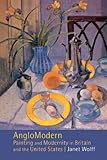AngloModern : Painting and Modernity in Britain and the United States / Janet Wolff.
Material type: TextPublisher: Ithaca, NY : Cornell University Press, [2018]Copyright date: ©2003Description: 1 online resource (192 p.) : 29 halftones, 1 tableContent type:
TextPublisher: Ithaca, NY : Cornell University Press, [2018]Copyright date: ©2003Description: 1 online resource (192 p.) : 29 halftones, 1 tableContent type: - 9781501717468
- 709/.41/0904
- online - DeGruyter
| Item type | Current library | Call number | URL | Status | Notes | Barcode | |
|---|---|---|---|---|---|---|---|
 eBook
eBook
|
Biblioteca "Angelicum" Pont. Univ. S.Tommaso d'Aquino Nuvola online | online - DeGruyter (Browse shelf(Opens below)) | Online access | Not for loan (Accesso limitato) | Accesso per gli utenti autorizzati / Access for authorized users | (dgr)9781501717468 |
Frontmatter -- Contents -- List of Illustrations -- Acknowledgments -- INTRODUCTION. AngloModern: The Painting of Modern Life -- 1. Women at the Whitney, 1910–30: Feminism, Sociology, Aesthetics -- 2. Questions of Discovery: The Art of Kathleen McEnery -- 3. Gender and the Haunting of Cities: Or, the Retirement of the Flaneur -- 4. The Feminine in Modern Art: Benjamin, Simmel, and the Gender of Modernity -- 5. The Failure of a Hard Sponge: Class, Ethnicity, and the Art of Mark Gertler -- 6. The "Jewish Mark" in English Painting: Cultural Identity and Modern Art -- AFTERWORD. Modernism, Realism, Revisionism -- Index
restricted access online access with authorization star
http://purl.org/coar/access_right/c_16ec
Early twentieth-century art and art practice in Britain and the United States were, Janet Wolff asserts, marginalized by critics and historians in very similar ways after the rise of post-Cubist modern art. In a masterly book on the sociology of modernism, Wolff explores work that was primarily realist and figurative and investigates the social, institutional, political, and aesthetic processes by which that art fell by the wayside in the postwar period. Throughout, she shows that questions of gender and ethnicity play an important role in critical, curatorial, and historical evaluations. For example, Wolff finds that the work of the artists central to the development of the Whitney Museum was relegated to a secondary status in the postwar period, when realism was labeled "feminine" in contrast to the aggressive masculinity of abstract expressionism.The three key periods considered in AngloModern are the early twentieth century, when modernist art and existing and new realist traditions coexisted in a certain tension; the postwar period, in which modernism claimed superiority over realism; and the late twentieth century, when a retrieval of the realist and figurative traditions seemed to occur. Wolff concludes by considering this re-emergence, as well as the limitations of earlier discussions of the struggles of realist and figurative art to endure the currents of modernism.
Mode of access: Internet via World Wide Web.
In English.
Description based on online resource; title from PDF title page (publisher's Web site, viewed 26. Apr 2024)


